ASUS E35M1-M Pro Review - Anyone For Fusion?
by Brendan van Varik on October 25, 2011 5:00 AM EST- Posted in
- Asus
- Motherboards
- Fusion
- E-350
LAN Speed Test
LAN Speed Test is a freeware program designed for testing the network connection between two PCs on a home network. The speed of the transfer is limited by the lowest common denominator on the network, so if you have gigabit Ethernet capable computers but a 100 Mbit capable router, you are limited to 100 Mbit transfer. Note that this is really a formality – if a network port is rated at 1 Gbps, then chances are that it will hit at least 90+% of this value. The main test here is CPU usage, and how much is offloaded by the controller. For this test, we use LAN Speed Test to transfer a 1000 MB file across a home network with a 1000 Mbps lowest common speed to the same machine each time, in a read/write scenario.
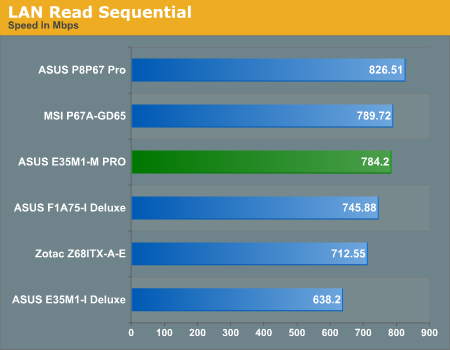
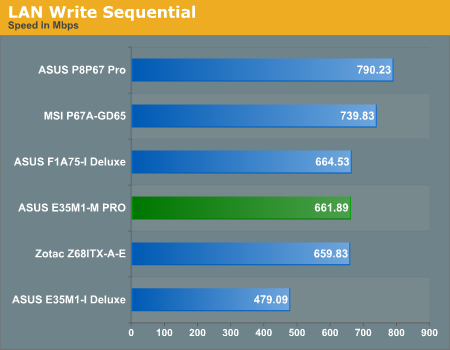
As we only have two results on the A50M platform which were tested under a 1 Gbps environment, I have decided to compare it to a few other platforms too. LAN throughput should be down to the onboard chip and therefore it has been compared to these platforms. Judging by the read and write speeds, the E35M1-M Pro does well for itself and is above average in the read tests but falls just under the average marker with the write tests.
USB Speed
For this benchmark, we run CrystalDiskMark to determine the ideal sequential read and write speeds for the USB port using our 64GB Patriot SuperSpeed USB 3.0 drive. Then we transfer a set size of files from the SSD to the USB drive, and monitor the time taken to transfer. The files transferred are a 1.52 GB set of 2867 files across 320 folders – 95% of these files are small typical website files, and the rest (90% of the size) are the videos used in the Sorenson Squeeze test.

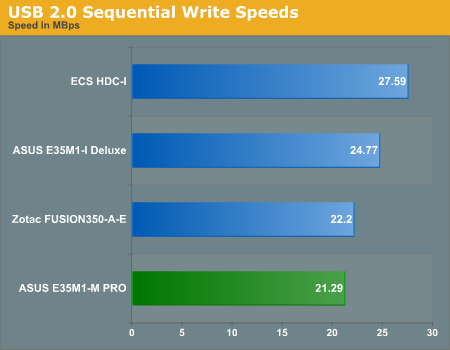
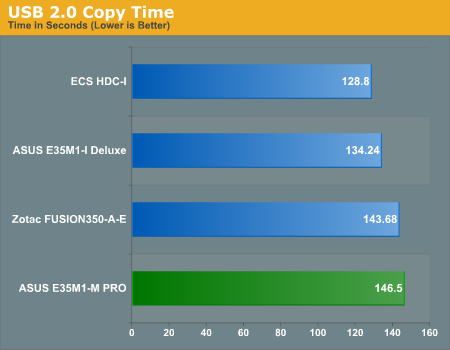
The USB 2.0 read speeds are above average out of the four boards but the writes on the other hand come in at bottom place. The reason for this is unknown.
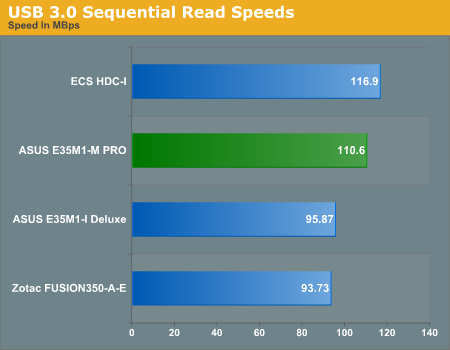

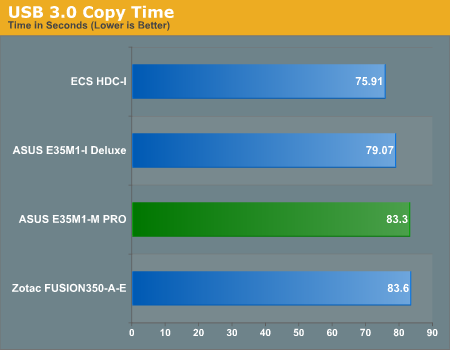
Write speeds on the USB 3.0 side of things are much better than the USB 2.0 results and the read speeds are above average here as well.
SATA Testing
We also use CrystalDiskMark for SATA port testing. The operating system is installed on the OCZ Vertex 3 240GB SSD, which is rated at up to 550 MB/s read and up to 520 MB/s write, and the sequential test is run at the 5 x 1000 MB level on a separate clean partition. This test probes the efficiency of the data delivery system between the chipset and the drive, or in the case of additional SATA ports provided by a third party controller, the efficiency between the controller, the chipset and the drive.


In the Vertex 3 testing the board got the fastest read speeds for A50M but the write speeds were below average. It is debatable whether a user would notice this is regular usage for this board, however.
DPC Latency
Deferred Procedure Call latency is a way in which Windows handles interrupt servicing. In order to wait for a processor to acknowledge the request, the system will queue all interrupt requests by priority. Critical interrupts will be handled as soon as possible, whereas lesser priority requests, such as audio, will be further down the line. So if the audio device requires data, it will have to wait until the request is processed before the buffer is filled. If the device drivers of higher priority components in a system are poorly implemented, this can cause delays in request scheduling and process time, resulting in an empty audio buffer – this leads to characteristic audible pauses, pops and clicks. Having a bigger buffer and correctly implemented system drivers obviously helps in this regard. The DPC latency checker measures how much time is processing DPCs from driver invocation – the lower the value will result in better audio transfer at smaller buffer sizes. Results are measured in microseconds and taken as the peak latency while cycling through a series of short HD videos - under 500 microseconds usually gets the green light, but the lower the better.

The E35M1-M PRO currently holds the lowest DPC Latency score in our records for the A50M platform.










66 Comments
View All Comments
C300fans - Tuesday, October 25, 2011 - link
No, because 80sp is really really too weak for gaming.C300fans - Tuesday, October 25, 2011 - link
Even if a 800sp card, GDDR5 128bit is far enough. Can you tell the difference between HD 6790 and HD 6770? I could say, you will probably notice more on the price.silverblue - Tuesday, October 25, 2011 - link
The difference here is that the memory interface is shared by both the CPU and the GPU. It's not all about gaming, but the actual effective use of what's on offer.However, being a geek at heart, I wouldn't mind seeing what the turbo mode plus more memory bandwidth would do for light gaming as well as if the E-450 is only a tiny bit faster than the E-350 even with the extra bandwidth.
duploxxx - Tuesday, October 25, 2011 - link
its already been tested, between 5-10% more perf in general tasks with same consumption. Not bad at all for a small update. No graphics tested yethttp://asia.cnet.com/product/hp-pavilion-dm1-amd-f...
lestr - Tuesday, October 25, 2011 - link
Lap top/netbook review, does not equal desktop especially in a "review" that is a mere single page, maybe two, max. The 350 OC's to ~1.8 +/- and with memory upped to 1600 on a 6320 graphics core the results might be more interesting especially since folks are only now beginning to understand how to OC an APU properly. Drop the mult, crank the FSB for graphics and raise both to stable. That noted, it's certainly not about gaming but over all performance. 80SP's isn't much but more power/speed wouldn't hurt, now would it? 160 would be great. Maybe CPU can get to 2.0 or greater...
Also promised are reviews geared more toward HTPC use rather than gaming... that's like trying to take out an elefunk with a BB gun. Not much point in even going there.
Actually I am more interested in what is going to replace the M50 - 350/450 line - Jan? For now it looks like they're trying to deplete 350 inventories before bringing the 450 here. Even so, a lot of people would like to know.
thanks it's nice to see the interest.
rburnham - Tuesday, October 25, 2011 - link
This board seems too big for an HTPC and too underpowered for a gaming rig. Most people I know who use their computers for basic things (web browsing, spreadsheets) already have laptops and they prefer the portability over a desktop. I am not sure where this board fits in.mino - Wednesday, October 26, 2011 - link
This board is actuall;y great for HTPC for a very important reason - there are people who actually _need_ more than a single PCIe or PCI slot ...But otherwise, the real target would be cheap PC's for kids, secretaries and the like.
jrs77 - Tuesday, October 25, 2011 - link
I'm owning a Zotac IONITX A-E (used as NAS/webclient), an Asus AT3IONT-I Deluxe (used as HTPC) and a Lenovo Thinkpad x121e E350 (for travelling and whatever). All of them are basically the same when it comes to powerconsumption and they're all up to the task of playing Full HD-media.People will allways moan about the low-power CPUs of those systems, but if you don't do anything else then browsing the web and playback some media, there's nothing to complain about really. These systems even run older games perfectly fine, or they make for a good system to run a second client for EvE Online, etc.
Geofram - Tuesday, October 25, 2011 - link
In windows, will it stream Netflix without a problem?I used to have a Atom based HTPC, and HD content on Netflix wouldn't properly use the GPU acceleration, and hence, it wouldn't play smoothly. Something in the Silverlight acceleration didn't detect and use GPU for everything, and would fall back to CPU. So I'm more worried about that than I am about if it will play a Blu-ray, yet it's something I never see checked.
RayMort - Wednesday, October 26, 2011 - link
This is exactly what I need to know too. My 6 year old PC with an AMD 3500 dual core processor can't decode Netflix HD streaming for the same reasons. I want to upgrade, but I want to be sure it will do Neflix HD before I purchase.